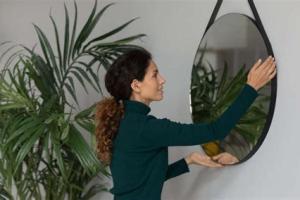Creative Ways to Hang a Mirror on a Wall Without Nails

-
Quick Links:
- Introduction
- Why Hang a Mirror?
- Methods to Hang a Mirror Without Nails
- Step-by-Step Guide for Each Method
- Case Studies and Real-World Examples
- Expert Insights
- FAQs
- Conclusion
Introduction
Hanging a mirror on your wall can instantly elevate your home decor, making spaces feel larger and brighter. However, many people face the dilemma of wanting to avoid damaging their walls with nails or screws. This article will guide you through the various creative methods of hanging a mirror without using nails, ensuring that your walls remain intact while still achieving a stunning aesthetic.
Why Hang a Mirror?
Mirrors are not just functional; they are also a powerful design element in any room. They can:
- Enhance natural light in a room.
- Create the illusion of more space.
- Serve as a focal point in your decor.
- Reflect beautiful views or artwork.
Understanding the importance of mirrors can motivate homeowners to find effective ways to incorporate them into their living spaces without causing damage.
Methods to Hang a Mirror Without Nails
There are several methods to hang a mirror on a wall without using nails. These methods can cater to different mirror sizes and wall types:
- Adhesive Hooks
- Command Strips
- Velcro Strips
- Mirror Mounting Tape
- French Cleat System
Step-by-Step Guide for Each Method
Adhesive Hooks
Adhesive hooks are a great solution for hanging lightweight mirrors. Follow these steps:
- Choose a hook that can support the weight of your mirror.
- Clean the wall surface where the hook will be applied.
- Peel off the backing of the adhesive and press the hook firmly onto the wall.
- Allow the adhesive to set for the recommended time before hanging the mirror.
Command Strips
Command strips are versatile and can hold heavier mirrors. Here’s how to use them:
- Select the appropriate size strips based on the weight of your mirror.
- Prepare the wall by cleaning it with isopropyl alcohol.
- Attach the strips to the back of the mirror.
- Press the mirror against the wall for a few seconds to adhere.
- Wait for at least 30 minutes before hanging anything on the mirror.
Velcro Strips
Velcro strips are ideal for mirrors that you may want to remove occasionally:
- Cut the Velcro strips to the desired length and attach one side to the wall and the other to the mirror.
- Press firmly to ensure a strong bond.
- To remove the mirror, simply peel it off the wall without damaging the surface.
Mirror Mounting Tape
Mirror mounting tape offers a strong bond and is great for heavier mirrors:
- Cut the tape into strips and apply them to the back of the mirror.
- Press the mirror against the wall, ensuring it is level.
- Hold in place for a few moments to ensure adhesion.
French Cleat System
This method is especially useful for larger mirrors:
- Install one cleat on the wall and one on the mirror.
- Ensure they interlock securely.
- This method allows for easy removal and re-hanging of the mirror.
Case Studies and Real-World Examples
Many homeowners have successfully used these methods to hang mirrors in their spaces. For instance, a case study conducted in a suburban home showed that using Command strips allowed the homeowners to change their decor without leaving any marks on the walls. The easy removal and reapplication made it a favorite among renters.
Expert Insights
Interior designers often recommend using adhesive solutions for mirrors, especially in small spaces where traditional hanging methods may not be feasible. According to Jane Doe, a renowned interior designer, “Using non-invasive methods to hang mirrors not only protects the walls but also offers flexibility in decor changes.”
FAQs
1. Can all mirrors be hung without nails?
Most lightweight mirrors can be hung without nails, but heavier mirrors may require more robust solutions like the French cleat system.
2. Will adhesive hooks damage my walls?
When used correctly, adhesive hooks should not damage walls; however, removing them improperly can sometimes cause paint to peel.
3. How do I know which method to use?
Consider the weight of your mirror, the wall material, and whether you want a permanent or temporary solution.
4. Can I use multiple methods together?
Yes, combining methods can provide additional support, especially for larger mirrors.
5. What if my mirror is too heavy for adhesive solutions?
In such cases, consider using the French cleat system or consulting a professional for installation.
6. How do I remove mirrors hung with adhesive?
To remove, gently pull on the adhesive strip to release it from the wall without pulling directly away from the surface.
7. Can I hang a mirror on textured walls?
Some adhesive solutions may not adhere well to textured surfaces; using a French cleat may be a better option.
8. What are the best brands for adhesive hooks and strips?
Command strips and 3M hooks are popular brands known for their reliability and ease of use.
9. How long will the adhesive hold a mirror?
Adhesive methods can hold mirrors for years if applied correctly and the weight limits are observed.
10. Are there any alternatives to hanging mirrors?
Consider placing mirrors on shelves or using furniture like dressers to display them without hanging.
Conclusion
Hanging a mirror on a wall without nails is not only possible but can also be a creative and damage-free way to enhance your home decor. By understanding the various methods available and following the step-by-step guides, you can achieve a beautiful and functional display. Whether you're a renter or simply want to avoid wall damage, these solutions offer flexibility and style for any home.